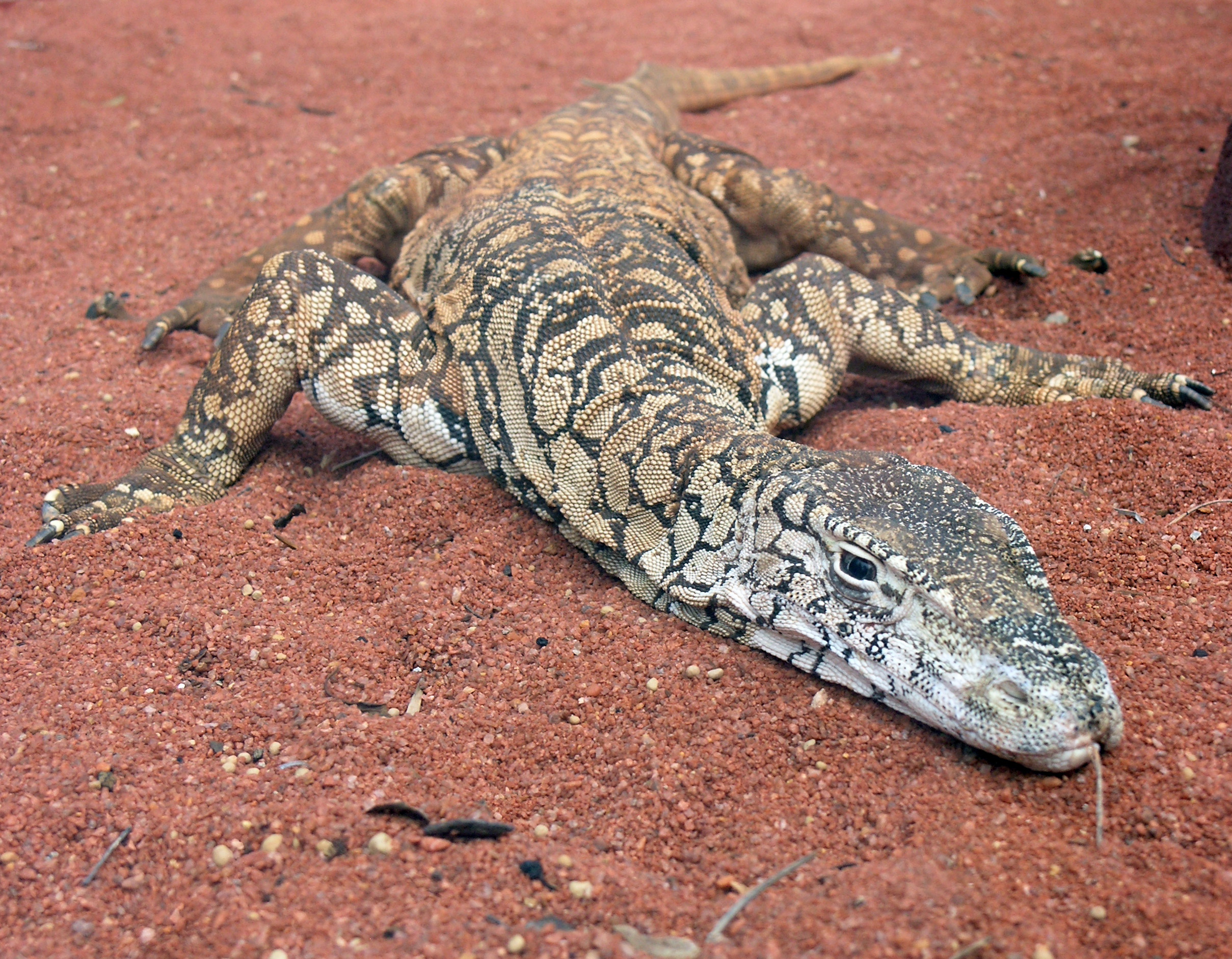- Perentie
Taxobox
name = Perentie
status = secure

image_width = 275px
image_caption = Perentie Lizard atPerth Zoo
regnum =Animal ia
phylum = Chordata
classis = Reptilia
ordo =Squamata
subordo =Scleroglossa
familia =Varanidae
genus = "Varanus "
species = "V. giganteus"
binomial = "Varanus giganteus"
binomial_authority = (Gray,1845 )The Perentie "(Varanus giganteus)" is the largest
monitor lizard orgoanna native toAustralia , and fourth largest lizard on earth, after theKomodo Dragon ,crocodile monitor and thewater monitor . Found west of theGreat Dividing Range in the arid areas of Australia, they are not a common sight on account of their shyness and remoteness of much of their range from human habitation.Their status in Indigenous Aboriginal culture is evident in the totemic relationship, and part of a dreaming, as well as bush tucker. They were a favoured food item among desert Aboriginal tribes, and the fat was used for medicinal and ceremonial purposes. Many are depicted in Aboriginal art and their accompanying stories such as the piece ‘Goanna Calling for Rain’ and ‘How the Perentie and Goanna got their Colours’. [Goanna. Aboriginal Tourism - Indigenous Australia - Iconography and Symbols (Travel Australia with AusEmade). [http://www.ausemade.com.au/aboriginal/resources/symbols/symbols_goanna.htm] ]
Description
The lizard can grow up to 2.5 metres (8 ft) in length although the average length is around 1.75-2 metres (5.5-6.5 ft) and weigh up to 15 kg (33 lb),maximum weight can be over 20 kg. Their rival for third largest lizard is the
crocodile monitor . Crocodile Monitors are longer, and often exceed 8 feet in length, but perenties are heavier and bulkier than the crocodile monitor. However, Perenties are relatively lean lizards, less bulky than either the Komodo dragon or the water monitor.Venom
In late 2005,
University of Melbourne researchers discovered thatPerentie s ("Varanus giganteus"), other monitors andIguania ns may be somewhatvenomous . Previously, it had been thought that bites inflicted by these lizards were simply prone to infection because of bacteria in the lizards' mouths, but these researchers have shown that the immediate effects are caused by mild envenomation. Bites on human digits by aLace Monitor ("Varanus varius"), aKomodo Dragon ("V. komodoensis") and aSpotted Tree Monitor ("V. scalaris") have been observed and all produced similar results in humans: rapid swelling within minutes, localised disruption of blood clotting, shooting pain up to the elbow, with some symptoms lasting for several hours. [Fry, Brian G., et al. (2006). "Early evolution of the venom system in lizards and snakes." "Nature". Letters. Vol. 439/2 February 2006, pp. 584-588. Pdf file available for download at: [http://scholar.google.com/scholar?hl=en&q=%22Early%20evolution%20of%20the%20venom%20system%20in%20lizards%20and%20snakes%22%20Letters%20Nature%2010.1038&oe=UTF-8&um=1&ie=UTF-8&sa=N&tab=ws] ]According to some Australian
wives' tales , the perentie is immune to the bite of venomous snakes. This folklore has not been experimentally tested in light of the discovery that the perentie is itself venomous.Distribution and habitat
* Arid
* Rocky with hard packed soil and some other loose rock matterBehaviour
Perenties are not a common sight in Australia: they are hard to find, and usually evade any human "looker" before the "looker" has a chance to see them.
They can stand on their back legs and tail to gain a better view of the surrounding terrain. This behaviour, known as "tripoding", is quite common to all monitors large and small. Perenties are fast sprinters, running using either all four legs or just their hind legs.
Diet
Perenties generally forage for their food, but are also known to wait for small animals to come to them. Prey include:
* Insects
* Reptiles, including their own kind
* Birds and birds' eggs
* Small mammals
*Carrion Large adults can attack larger prey, like small kangaroos.Footnotes
References
* Cogger, H. (1967). "Australian Reptiles in Colour". Sydney: A. H. & A. W. Reed, ISBN 0-589-07012-6
* King, Dennis & Green, Brian. 1999. "Goannas: The Biology of Varanid Lizards". University of New South Wales Press. ISBN 0-86840-456-XExternal links
Wikimedia Foundation. 2010.
